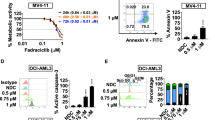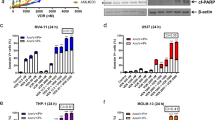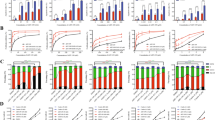Abstract
SNS-032 (BMS-387032) is a selective cyclin-dependent kinase (CDK) inhibitor. In this study, we evaluated its effects on primary acute myeloid leukemia (AML) samples (n=87). In vitro exposure to SNS-032 for 48 h resulted in a mean LD50 of 139±203 nM; Cytarabine (Ara-C) was more than 35 times less potent in the same cohort. SNS-032-induced a dose-dependent increase in annexin V staining and caspase-3 activation. At the molecular level, SNS-032 induced a marked dephosphorylation of serine 2 and 5 of RNA polymerase (RNA Pol) II and inhibited the expression of CDK2 and CDK9 and dephosphorylated CDK7. Furthermore, the combination of SNS-032 and Ara-C showed remarkable synergy that was associated with reduced mRNA levels of the antiapoptotic genes XIAP, BCL2 and MCL1. In conclusion, SNS-032 is effective as a single agent and in combination with Ara-C in primary AML blasts. Treatment with Ara-C alone significantly induced the transcription of the antiapoptotic genes BCL2 and XIAP. In contrast, the combination of SNS-032 and Ara-C suppressed the transcription of BCL2, XIAP and MCL1. Therefore, the combination of SNS-032 and Ara-C may increase the sensitivity of AML cells to the cytotoxic effects of Ara-C by inhibiting the transcription of antiapoptotic genes.
This is a preview of subscription content, access via your institution
Access options
Subscribe to this journal
Receive 12 print issues and online access
$259.00 per year
only $21.58 per issue
Buy this article
- Purchase on Springer Link
- Instant access to full article PDF
Prices may be subject to local taxes which are calculated during checkout






Similar content being viewed by others
References
Kiyoi H, Naoe T . Biology, clinical relevance, and molecularly targeted therapy in acute leukemia with FLT3 mutation. Int J Hematol 2006; 83: 301–308.
Sanz M, Burnett A, Lo-Coco F, Lowenberg B . FLT3 inhibition as a targeted therapy for acute myeloid leukemia. Curr Opin Oncol 2009; 21: 594–600.
Mesters RM, Padro T, Bieker R, Steins M, Kreuter M, Goner M et al. Stable remission after administration of the receptor tyrosine kinase inhibitor SU5416 in a patient with refractory acute myeloid leukemia. Blood 2001; 98: 241–243.
Giles FJ, Stopeck AT, Silverman LR, Lancet JE, Cooper MA, Hannah AL et al. SU5416, a small molecule tyrosine kinase receptor inhibitor, has biologic activity in patients with refractory acute myeloid leukemia or myelodysplastic syndromes. Blood 2003; 102: 795–801.
Mountzios G, Terpos E, Dimopoulos MA . Aurora kinases as targets for cancer therapy. Cancer Treat Rev 2008; 34: 175–182.
Wallenfang MR, Seydoux G . cdk-7 Is required for mRNA transcription and cell cycle progression in Caenorhabditis elegans embryos. Proc Natl Acad Sci USA 2002; 99: 5527–5532.
Shapiro GI . Cyclin-dependent kinase pathways as targets for cancer treatment. J Clin Oncol 2006; 24: 1770–1783.
Scrace SF, Kierstan P, Borgognoni J, Wang LZ, Denny S, Wayne J et al. Transient treatment with CDK inhibitors eliminates proliferative potential even when their abilities to evoke apoptosis and DNA damage are blocked. Cell Cycle 2008; 7: 3898–3907.
Maude SL, Enders GH . Cdk inhibition in human cells compromises chk1 function and activates a DNA damage response. Cancer Res 2005; 65: 780–786.
Cai D, Latham Jr VM, Zhang X, Shapiro GI . Combined depletion of cell cycle and transcriptional cyclin-dependent kinase activities induces apoptosis in cancer cells. Cancer Res 2006; 66: 9270–9280.
Yu C, Rahmani M, Dai Y, Conrad D, Krystal G, Dent P et al. The lethal effects of pharmacological cyclin-dependent kinase inhibitors in human leukemia cells proceed through a phosphatidylinositol 3-kinase/Akt-dependent process. Cancer Res 2003; 63: 1822–1833.
Grant S, Roberts JD . The use of cyclin-dependent kinase inhibitors alone or in combination with established cytotoxic drugs in cancer chemotherapy. Drug Resist Updat 2003; 6: 15–26.
Lolli G, Johnson LN . CAK-Cyclin-dependent activating kinase: a key kinase in cell cycle control and a target for drugs? Cell Cycle 2005; 4: 572–577.
Larochelle S, Pandur J, Fisher RP, Salz HK, Suter B . Cdk7 is essential for mitosis and for in vivo Cdk-activating kinase activity. Genes Dev 1998; 12: 370–381.
Shuttleworth J . The regulation and functions of cdk7. Prog Cell Cycle Res 1995; 1: 229–240.
Chen R, Wierda WG, Chubb S, Hawtin RE, Fox JA, Keating MJ et al. Mechanism of action of SNS-032, a novel cyclin-dependent kinase inhibitor, in chronic lymphocytic leukemia. Blood 2009; 113: 4637–4645.
Dickson MA, Schwartz GK . Development of cell-cycle inhibitors for cancer therapy. Curr Oncol 2009; 16: 36–43.
Ali MA, Choy H, Habib AA, Saha D . SNS-032 prevents tumor cell-induced angiogenesis by inhibiting vascular endothelial growth factor. Neoplasia 2007; 9: 370–381.
Chou TC, Talalay P . Quantitative analysis of dose-effect relationships: the combined effects of multiple drugs or enzyme inhibitors. Adv Enzyme Regul 1984; 22: 27–55.
White JC, Rathmell JP, Capizzi RL . Membrane transport influences the rate of accumulation of cytosine arabinoside in human leukemia cells. J Clin Invest 1987; 79: 380–387.
Chen R, Keating MJ, Gandhi V, Plunkett W . Transcription inhibition by flavopiridol: mechanism of chronic lymphocytic leukemia cell death. Blood 2005; 106: 2513–2519.
Yu C, Rahmani M, Dai Y, Conrad D, Krystal G, Dent P et al. The lethal effects of pharmacological cyclin-dependent kinase inhibitors in human leukemia cells proceed through a phosphatidylinositol 3-kinase/Akt-dependent process. Cancer Res 2003; 63: 1822–1833.
Rosato RR, Almenara JA, Kolla SS, Maggio SC, Coe S, Gimenez MS et al. Mechanism and functional role of XIAP and Mcl-1 down-regulation in flavopiridol/vorinostat antileukemic interactions. Mol Cancer Ther 2007; 6: 692–702.
Maung ZT, MacLean FR, Reid MM, Pearson AD, Proctor SJ, Hamilton PJ et al. The relationship between bcl-2 expression and response to chemotherapy in acute leukaemia. Br J Haematol 1994; 88: 105–109.
Karakas T, Maurer U, Weidmann E, Miething CC, Hoelzer D, Bergmann L . High expression of bcl-2 mRNA as a determinant of poor prognosis in acute myeloid leukemia. Ann Oncol 1998; 9: 159–165.
Notarbartolo M, Cervello M, Dusonchet L, Cusimano A, D’Alessandro N . Resistance to diverse apoptotic triggers in multidrug resistant HL60 cells and its possible relationship to the expression of P-glycoprotein, Fas and of the novel anti-apoptosis factors IAP (inhibitory of apoptosis proteins). Cancer Lett 2002; 180: 91–101.
Carter BZ, Mak DH, Schober WD, Dietrich MF, Pinilla C, Vassilev LT et al. Triptolide sensitizes AML cells to TRAIL-induced apoptosis via decrease of XIAP and p53-mediated increase of DR5. Blood 2008; 111: 3742–3750.
Lubbert M, Muller-Tidow C, Hofmann WK, Koeffler HP . Advances in the treatment of acute myeloid leukemia: from chromosomal aberrations to biologically targeted therapy. J Cell Biochem 2008; 104: 2059–2070.
Estey E . New drugs in acute myeloid leukemia. Semin Oncol 2008; 35: 439–448.
Renneville A, Roumier C, Biggio V, Nibourel O, Boissel N, Fenaux P et al. Cooperating gene mutations in acute myeloid leukemia: a review of the literature. Leukemia 2008; 22: 915–931.
Buolamwini JK . Cell cycle molecular targets in novel anticancer drug discovery. Curr Pharm Des 2000; 6: 379–392.
Raje N, Kumar S, Hideshima T, Roccaro A, Ishitsuka K, Yasui H et al. Seliciclib (CYC202 or R-roscovitine), a small-molecule cyclin-dependent kinase inhibitor, mediates activity via down-regulation of Mcl-1 in multiple myeloma. Blood 2005; 106: 1042–1047.
Tirado OM, Mateo-Lozano S, Notario V . Roscovitine is an effective inducer of apoptosis of Ewing's sarcoma family tumor cells in vitro and in vivo. Cancer Res 2005; 65: 9320–9327.
Hui AB, Yue S, Shi W, Alajez NM, Ito E, Green SR et al. Therapeutic efficacy of seliciclib in combination with ionizing radiation for human nasopharyngeal carcinoma. Clin Cancer Res 2009; 15: 3716–3724.
Drexler HG, Quentmeier H, MacLeod R . Cell line models of leukemia. Drug Discov Today: Disease Models 2005; 2: 51–56.
Moon JH, Sohn SK, Lee MH, Jang JH, Kim K, Jung CW et al. BCL2 gene polymorphism could predict the treatment outcomes in acute myeloid leukemia patients. Leuk Res 2010; 34: 166–172.
Kornblau SM, Thall PF, Estrov Z, Walterscheid M, Patel S, Theriault A et al. The prognostic impact of BCL2 protein expression in acute myelogenous leukemia varies with cytogenetics. Clin Cancer Res 1999; 5: 1758–1766.
Tamm I, Kornblau SM, Segall H, Krajewski S, Welsh K, Kitada S et al. Expression and prognostic significance of IAP-family genes in human cancers and myeloid leukemias. Clin Cancer Res 2000; 6: 1796–1803.
Konopleva M, Tari AM, Estrov Z, Harris D, Xie Z, Zhao S et al. Liposomal Bcl-2 antisense oligonucleotides enhance proliferation, sensitize acute myeloid leukemia to cytosine-arabinoside, and induce apoptosis independent of other antiapoptotic proteins. Blood 2000; 95: 3929–3938.
Ibrado AM, Huang Y, Fang G, Liu L, Bhalla K . Overexpression of Bcl-2 or Bcl-xL inhibits Ara-C-induced CPP32/Yama protease activity and apoptosis of human acute myelogenous leukemia HL-60 cells. Cancer Res 1996; 56: 4743–4748.
Misra RN, Xiao HY, Kim KS, Lu S, Han WC, Barbosa SA et al. N-(cycloalkylamino)acyl-2-aminothiazole inhibitors of cyclin-dependent kinase 2. N-[5-[[[5-(1,1-dimethylethyl)-2-oxazolyl]methyl]thio]-2-thiazolyl]-4- piperidinecarboxamide (BMS-387032), a highly efficacious and selective antitumor agent. J Med Chem 2004; 47: 1719–1728.
Byrd JC, Lin TS, Dalton JT, Wu D, Phelps MA, Fischer B et al. Flavopiridol administered using a pharmacologically derived schedule is associated with marked clinical efficacy in refractory, genetically high-risk chronic lymphocytic leukemia. Blood 2007; 109: 399–404.
Heath EI, Bible K, Martell RE, Adelman DC, Lorusso PM . A phase 1 study of SNS-032 (formerly BMS-387032), a potent inhibitor of cyclin-dependent kinases 2, 7 and 9 administered as a single oral dose and weekly infusion in patients with metastatic refractory solid tumors. Invest New Drugs 2008; 26: 59–65.
Author information
Authors and Affiliations
Corresponding author
Ethics declarations
Competing interests
The authors declare no conflict of interest.
Additional information
Supplementary Information accompanies the paper on the Leukemia website
Supplementary information
Rights and permissions
About this article
Cite this article
Walsby, E., Lazenby, M., Pepper, C. et al. The cyclin-dependent kinase inhibitor SNS-032 has single agent activity in AML cells and is highly synergistic with cytarabine. Leukemia 25, 411–419 (2011). https://doi.org/10.1038/leu.2010.290
Received:
Revised:
Accepted:
Published:
Issue Date:
DOI: https://doi.org/10.1038/leu.2010.290
Keywords
This article is cited by
-
Targeting cyclin-dependent kinase 9 in cancer therapy
Acta Pharmacologica Sinica (2022)
-
CDK9 inhibitors in acute myeloid leukemia
Journal of Experimental & Clinical Cancer Research (2018)
-
Interactions of cyclin-dependent kinase inhibitors AT-7519, flavopiridol and SNS-032 with ABCB1, ABCG2 and ABCC1 transporters and their potential to overcome multidrug resistance in vitro
Cancer Chemotherapy and Pharmacology (2015)
-
Synthesis and antitumor activity of 4-tert-butyl-5-benzyl-2-benzyliminothiazoles
Chemical Research in Chinese Universities (2014)
-
SNS-032 inhibits mTORC1/mTORC2 activity in acute myeloid leukemia cells and has synergistic activity with perifosine against Akt
Journal of Hematology & Oncology (2013)



